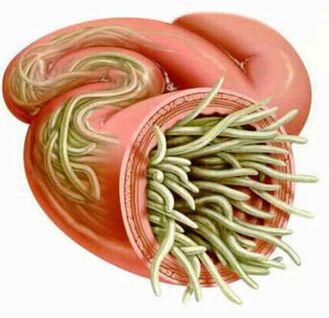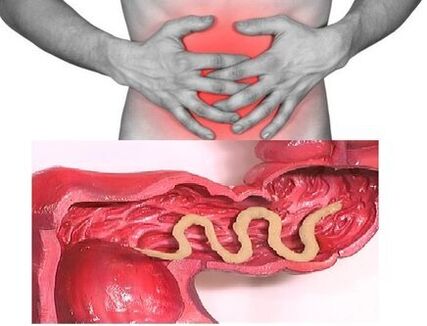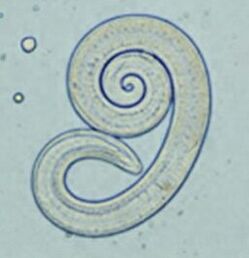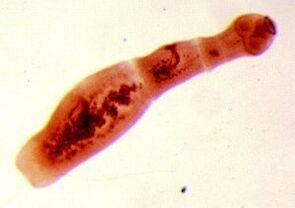To date, science knows about 280 types of worms that can develop and live in the human body, parasitizing in various organs and tissues. The frequency of human worm infection depends on the climatic and socio-economic conditions of specific territories (in underdeveloped countries, especially in those located in the tropical and subtropical zones, the level of parasitic infections is much higher than in economically developed countries).
Ways of human infection with helminths
- Biohelminthiasis (infection from animals).
- Contagious helminthiases (transmitted from person to person).
- Geohelminthiasis (diseases caused by parasites that carry out one of their life cycles in the earth).
Factors affecting the manifestations of helminthiasis
- The way the parasite enters the body;
- The degree of adaptation of the helminth to the human body;
- Population density (number) of parasitic individuals;
- The habitat of the worm (tissue parasites live in the thickness of soft tissues, and luminal ones live in the lumens of hollow organs). Some helminths in different phases have both luminal and tissue forms. Larval and developing stages of worms, as a rule, cause more pronounced pathological changes.

In the absence of re-infection, the number of adult parasites in the human body does not increase. This feature significantly distinguishes helminthic invasions from diseases caused by bacteria, viruses, fungi and protozoa.
Worms in humans: symptoms
Helminthiasis is a disease characterized by 2 stages of the course (acute, from two weeks to two months) and chronic (from several months to several years).
Symptoms of the acute phase of helminthiasis
The first signs of the disease can appear at different times (most often after 2-3 weeks, with ascariasis - after 2-3 days, and with filariasis, the incubation period can last 6-18 months).
In the acute stage of parasitic invasion, the most characteristic symptom is an allergic reaction (antibodies are produced to antigens of migrating parasite larvae). Often in people infected with worms, itchy rashes appear on the skin, prone to a recurrent course, regional lymph nodes increase, generalized or local edema, muscle and joint pain may occur. Also, migrating parasite larvae can cause chest pains, coughing, choking attacks, upset stools, nausea and vomiting.
At the same time, the acute phase of helminthiasis can be accompanied by more serious disorders (severe forms of pneumonia, hepatitis, allergic myocarditis, hepatosplenomegaly (enlarged liver and spleen), meningoencephalitis).
The number of eosinophils in the blood increases (eosinophilia) and the normal quantitative ratio between protein fractions is disturbed (dysproteinemia).
Signs of chronic helminthiasis
Symptoms of the chronic phase directly depend on which organ is "inhabited" by parasites, as well as their size and number play an important role. So, when parasitizing in the intestines of single individuals, the disease can be asymptomatic (except for cases of infection with very large parasites). The characteristic signs of the chronic phase of intestinal helminthiasis are dyspeptic disorders. In children, asthenoneurotic and pain syndrome is more pronounced. With massive invasion of roundworms, the development of intestinal obstruction, obstructive jaundice and pancreatitis is possible.
So, when parasitizing in the intestines of single individuals, the disease can be asymptomatic (except for cases of infection with very large parasites). The characteristic signs of the chronic phase of intestinal helminthiasis are dyspeptic disorders. In children, asthenoneurotic and pain syndrome is more pronounced. With massive invasion of roundworms, the development of intestinal obstruction, obstructive jaundice and pancreatitis is possible.
Consuming all the substances necessary for their vital activity from the host's body, helminths cause digestive disorders, impaired absorption of vitamins, minerals, carbohydrates, proteins and fats. At the same time, the waste products of worms inhibit the normal intestinal microflora and reduce the body's immune forces.
In people suffering from helminthiases, due to a weakened immune system and an enhanced process of cell division (a consequence of the constant restoration of tissues damaged by parasites), the risk of malignant tumors increases significantly.
Types of helminths parasitizing in the human body
The causative agents of human helminthiasis are 2 types of worms: round (nematodes) and flat (tapeworms and flukes).
Roundworms
Pinworm
The parasites that cause enterobiasis are small (up to 10mm) thin cavity worms with a grayish-white coloration. Infection occurs alimentary (through the mouth). The reason for this is dirty hands. The eggs of the parasite can be in the ground, on the wool of infected animals, unwashed vegetables and fruits, etc. At the same time, with enterobiasis, cases of self-infection are frequent (especially in children), resulting from scratching of the itchy areas and subsequent swallowing of eggs. The pinworm larva develops within two weeks in the digestive tract. Having turned into an adult, the worm parasitizes in the lower sections of the small and upper sections of the colon.
The pinworm larva develops within two weeks in the digestive tract. Having turned into an adult, the worm parasitizes in the lower sections of the small and upper sections of the colon.
Even in the larval stage, the pinworm begins to harm the body of its host, producing enzymes that irritate the intestinal walls and lead to the development of an inflammatory process. Adult parasites stick or penetrate into the deeper layers of the intestinal mucosa, disrupting its integrity and contributing to the attachment of a secondary bacterial infection. In the case of pinworms perforation of the wall of the small intestine, peritonitis may develop. Also, due to irritation of the intestinal receptors, the motor and secretory functions of the gastrointestinal tract are disrupted, leading to the formation of gastroduodenitis, enteritis, etc. In childhood, long-term enterobiasis can cause nervous disorders and retardation in physical development.
Ascaris
Ascaris is a large spindle-shaped parasite of red-yellow color, reaching 40 cm (females) and 15-25 cm (males) in adulthood. Without suction cups or other fastening devices, the roundworm is able to independently move towards the food masses. The eggs laid by the female of the parasite are excreted along with the feces.
Infection with ascariasis occurs when mature eggs are swallowed with water or unwashed vegetables and fruits that have soil particles. After the eggs enter the intestines, mature larvae emerge from them. Then, penetrating into the intestinal wall, they reach the heart through the bloodstream, and from there they enter the lungs. Through the pulmonary alveoli, the roundworm larva through the respiratory tract again enters the oral cavity. After repeated swallowing, the parasite reaches the small intestine, where it develops into an adult. The worm lives for 12 months, then dies and is excreted along with the feces. In the intestines of one host, both one and several hundred individuals can live.
In the intestinal phase of their existence, roundworms, endowed with the ability to spiral movements, can penetrate even the narrowest openings. This feature of the parasite often leads to the development of rather serious complications (obstructive jaundice or pancreatitis). Allergens secreted by roundworms can provoke severe allergic reactions. Large numbers of adults can cause intestinal obstruction, and worms that enter the respiratory tract sometimes cause suffocation.
Vlasoglav
Vlasoglav, the causative agent of trichocephalosis, is a white helminth parasitizing in the initial section of the large intestine and reaching a size of 4-5 cm. The parasite feeds on blood and tissues of the rectal mucosa.
The whipworm eggs laid by the female on the intestinal walls come out together with the feces. Their development takes place in the environment (optimally in the soil). Eggs with the larvae of the parasite ripened in them enter the body through alimentary means, through dirty hands, with water or unwashed vegetables and fruits.
With small numbers of worms, trichocephalosis is asymptomatic. In a severe stage (with massive invasion), the patient develops abdominal pain, severe diarrhea develops, sometimes accompanied by rectal prolapse. This condition is most often observed in debilitated children. With a moderate phase of trichocephalosis, a child's growth retardation is possible.
Trichinella
The causative agent of trichinosis is a small round helminth reaching 2-5 mm in length. Infection occurs when eating poorly roasted meat (pork, bear meat, wild boar). Penetrating into the intestines, the larva of the parasite matures in 3-4 days to the state of a sexually mature individual. The life span of the worm is 40 days, after which the parasite dies. By piercing the intestinal wall, the larvae enter the bloodstream and are carried to all organs of the human body, settling in the muscles. In this case, the respiratory and facial muscles, as well as the flexor muscles of the limbs, are most often affected.
Penetrating into the intestines, the larva of the parasite matures in 3-4 days to the state of a sexually mature individual. The life span of the worm is 40 days, after which the parasite dies. By piercing the intestinal wall, the larvae enter the bloodstream and are carried to all organs of the human body, settling in the muscles. In this case, the respiratory and facial muscles, as well as the flexor muscles of the limbs, are most often affected.
In the first days after the invasion, patients complain of abdominal pain. Then, after about 2 weeks, the body temperature rises to 39-40 C, itchy rashes appear on the skin, muscle pains develop, and the face swells. During this period, in the case of massive infection, there is a significant risk of death. After about a month, the patient recovers. The parasite is encapsulated in a spiral form, after which it dies within two years.
Hookworm and nekator
These two parasites are similar in biological characteristics, as well as in caused diseases. In this regard, it is customary to combine them under a common name (hookworms). Worms, reaching lengths of 10-15 mm, parasitize in 12-p. intestine. It should be noted that this is one of the most common, but, at the same time, quite rarely detected parasites. Worm larvae enter the human body through the skin upon contact with contaminated soil. Further, entering the bloodstream, they, like roundworms, migrate to the lungs, and then, through the bronchi, together with expectorant sputum, to the digestive tract. Ankylostoma parasitizes in the intestine, attaching itself to the intestinal wall. The parasite, which feeds exclusively on blood, bites through the blood vessels that penetrate the mucous membrane, injecting an anticoagulant component there. On average, an adult can absorb 0. 05-0. 35 ml of blood per day. Therefore, the most characteristic symptom of this helminthiasis is iron deficiency anemia, as well as a change in the ratio of protein fractions (dysproteinemia).
Flatworms
Wide ribbon
This is one of the largest helminths, reaching a length of 10-20 meters. The disease caused by this parasite is called diphyllobothriasis. The worm's developmental cycle begins with freshwater fish or crustaceans. The larva enters the human body, which is the final owner of the broad tapeworm, along with eggs or infected fish fillets. Reaching the small intestine, the parasite attaches to its wall and grows to a mature individual within 20-25 days.
Diphyllobothriasis occurs against the background of disorders of the digestive tract and B12-deficiency anemia.
Liver fluke
The parasite that causes opisthorchiasis is a flat worm reaching a length of 7-20 mm. It should be noted that more than 50% of cases of infection with the hepatic fluke (also called the cat fluke) occur in the inhabitants of Russia. The larvae of the parasite begin to develop after the eggs enter the fresh water (from the snails that have swallowed them). Then they penetrate into the body of fish (carp, crucian carp, bream, roach). Human infection occurs when eating contaminated fish meat that has not undergone sufficient heat treatment. The larva of the hepatic fluke from the small intestine penetrates into the bile ducts and into the gallbladder, fixing there with the help of two suction cups.
In the acute phase of helminthiasis, the patient has soreness in the upper abdomen, the body temperature rises, nausea develops, muscle pains, diarrhea, and skin rashes are possible. The chronic course of opisthorchiasis is manifested by symptoms of hepatitis, inflammation of the bile ducts, cholecystitis, disturbances in the digestive tract, nervous disorders, weakness and increased fatigue. The parasite leads to the development of irreversible changes, and even after its expulsion, the patient does not undergo chronic inflammatory processes and functional disorders.
Bovine and pork tapeworm
These parasites, almost identical in structure, reach a length of 5-6 meters. Infection with teniarinhoses and teniasis occurs due to the consumption of meat from cattle or pork infected by the Finns (one of the intermediate forms of helminthiasis). Viable Finns, presented in the form of whitish bubbles reaching 0. 5 cm in size, attach to the wall of the human small intestine and turn into an adult in 3 months. The tape parasite, consisting of more than 2000 segments, is constantly growing. In this case, the end segments, containing eggs, break off and independently move along the large intestine to the anus, and then crawl out of the anus, or are released into the external environment along with feces. The most characteristic symptoms of helminthiasis is disruption of the digestive tract.
Echinococcus
For this parasite, a person is an intermediate host. The worm parasitizes the human body in the form of the Finns. The final owner of echinococcus is a wolf, dog or cat.  Infection occurs alimentary through contact with animals and with environmental objects seeded with Echinococcus eggs. After entering the intestine, oncospheres (six-hooked larvae) develop from them. From the intestines, they enter the bloodstream and are carried throughout the body.
Infection occurs alimentary through contact with animals and with environmental objects seeded with Echinococcus eggs. After entering the intestine, oncospheres (six-hooked larvae) develop from them. From the intestines, they enter the bloodstream and are carried throughout the body.
The "favorite" parasitic sites of the worm are the liver and lungs. By settling in these organs, the larva turns into a Finn (echinococcal cyst), which, gradually increasing in size, begins to destroy nearby tissues. Often, echinococcosis in the diagnostic process is mistaken for a tumor of benign or malignant origin. In addition to mechanical action (squeezing of organs and blood vessels), echinococcal cyst rupture sometimes occurs. This condition can cause toxic shock or the formation of multiple new cysts.
Alveococcus
This parasite, considered a type of echinococcus, is the cause of one of the most dangerous helminthiases (alveococcosis), which is similar in severity to cirrhosis and liver cancer. Infection occurs when oncospheres (eggs with mature larvae) enter the intestine. There, the embryo leaves the egg and, penetrating into the intestinal walls, enters the bloodstream. Further, with the blood flow, the parasite spreads to all tissues and organs of the body (most often it is localized in the liver). It is there that the main stage of development begins in the larvae (a multi-chambered bubble, laurocyst is formed). Each chamber contains the embryonic head of the parasite, which continues to develop gradually. Laurocysts are very aggressive formations that constantly grow due to enlarging bubbles, and also have the ability to grow into the liver, like cancer metastases. Necrotic changes due to disturbances in the functioning of blood vessels undergo necrotic changes in nearby tissues. Spreading to nearby structures, the alveococcus forms fibrous nodes with inclusions of multicameral bubbles. This condition can last for several years, and therefore it requires mandatory surgical intervention.
Diagnostics of helminthiasis
Diagnostics of helminthic invasions includes the following activities:
- a thorough history taking, helping to find out the possible causes of infection;
- laboratory tests of feces, blood, intestinal 12p contents, rectal and perianal mucus, muscle tissue, pulmonary sputum, bile. The analysis may reveal eggs, segments or fragments of parasites. At the same time, an increased content of eosinophils in the blood is also a signal of the presence of helminthiasis.
- when diagnosing diseases caused by larval stages or tissue parasites, serological studies are carried out (ELISA, RSK, indirect agglutination reaction, immunofluorescence analysis, etc. ).
- ultrasound, CT and endoscopic examinations are prescribed to detect helminths that affect liver tissue.
Human worms: treatment
In the acute phase of a parasitic infection, the patient is prescribed detoxification and desensitization therapy. In severe cases of the disease (trematodes of the liver, trichinosis), glucocorticoids are used according to medical indications.
As drugs of specific therapy, taking into account the nature of the pathogen, special anthelmintic chemotherapeutic agents are prescribed.
In parallel, the patient is recommended to take antihistamines and enterosorbents. The final stage of treatment includes the use of probiotics that normalize the intestinal microflora.
A special sparing diet is also prescribed (food should be digestible and low in fat).
During the period of antihelminthic therapy, the patient is required to strictly observe personal hygiene (in order to avoid re-infection). At the same time, for many helminthiasis, all family members and persons who are in constant contact with the infected must undergo treatment.
Prevention of helminthiasis
- Maintaining personal and public hygiene;
- Strict adherence to cooking technology;
- Regular examination and preventive treatment of pets;
- Thorough washing of fresh vegetables, fruits and herbs;
- Proper handling of river fish;
- Avoiding the consumption of raw, slightly salted and dried fish.






































